Canoe Cove 48 Tri-Cabin
By Andy Adams
The Complete West Coast cruiser – big, rugged and luxurious. Twin turbo charged diesel give it spunk. It’s one of the larger quasi-custom craft built on the West Coast though it doesn’t need full crew and it won’t cross many oceans.
This month I’m looking at a somewhat larger craft than usual – the Canoe Cove 48 Tri-Cabin Coho built by Canoe Cove Manufacturing of Sidney, BC. The test boat, Tinker Toy, was built for the Cullen family of Cullen Detroit Diesel Allison. Cullen took a pair of basic 6-71 Tl engines and modified them at the Burnaby, BC, plant for marine use, adding turbochargers with inter-cooling, freshwater cooling through heat exchangers and mated all this to Vernatone 8-in. mufflers. ·
By the time the Cullen people were through, the 426-cu.-in. diesels were putting out 410 hp on the shop dynos. Give that a second thought: 410 hp from 426 cubic inches is very close to 1 hp per cubic inch, and it does it all at 2,500 rpm with only six cylinders.
Trying to get all that power into the water effectively is a Herculean task, handled in this case by Capital direct drives with reverse gear coupled to Walter’s V-drives at a ratio of 2:1, turning 28 in. by 28 in. four-bladed bronze props by Michigan.
With literally tens of thousands invested in engines, you need protection – more than just insurance – so the boat is fitted with Chicago Rawhide Water Separators with water alarm and high-water-temperature / low-oil-pressure alarm systems as well. There’s also another alarm for the V-drives in case the oil pressure there drops below 7 psi.
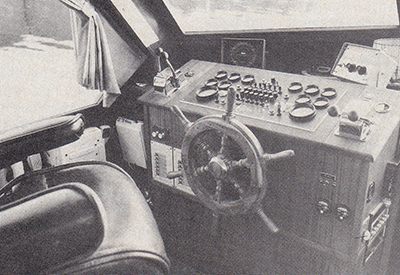 Out on the water is where all this gains some meaning. It’s just like driving a ski boat: ram the throttles wide open and the 48 rushes forward without hesitation. You would think that anything with well over 800 horse-power would go like lightning but you have to remember that this whole outfit weighs in at better than 43,000 lb. It is little short of remarkable then that we recorded a top end of 27 statute mph with the radar gun.
Out on the water is where all this gains some meaning. It’s just like driving a ski boat: ram the throttles wide open and the 48 rushes forward without hesitation. You would think that anything with well over 800 horse-power would go like lightning but you have to remember that this whole outfit weighs in at better than 43,000 lb. It is little short of remarkable then that we recorded a top end of 27 statute mph with the radar gun.
Surprisingly though, the 6-71 Tis are very tractable and behave beautifully, rarely showing any sign of temperament. The only time the engines were really even noticeable was when, running wide open, the cabin would experience some vibration. At normal operating speeds the engines were quiet and there was no vibration evident. I’m sure some of the credit here should go to the Vernatone mufflers.
The engine room itself is well laid out and had excellent access. The engines are located under the cockpit floor with a centre access hatch for routine inspection. The entire floor comes up if the engines need work. Actually, these are fairly compact power plants and occupy little of the boat’s total area. Just about the whole works fits into the aft five feet. The 12.5- kw Kohler generator and some tanks are mounted amidships.
My only comment about the way the Canoe Cove ran would be that it might prove advantageous to have more of the fixed weight forward in the hull. Our measurements of running angle indicated that the boat sat at a true angle of three degrees’ maximum. In other words, when the throttles were opened, the boat never came to the point of bringing its own bow down without the use of trim tabs and therefore sat slightly bow up in natural ride attitude. This is hardly a damning criticism – in fact, it may work out best for running in rough water – but my experience has been that a well-balanced hull should get its own bow down at higher speeds. Had the 48 gone just a touch faster, l’m sure that the bow would have come down of its own accord; likely the same would be true with a bit more weight forward. That is academic anyway, but could represent a fuel saving over the long term.
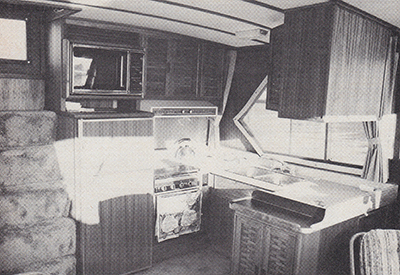 Handling was little short of amazing. While we were doing the photography in a series of fly-bys, we ran the boat in a tight series of figure eights. The owner of the boat had an ear-to-ear smile as he hauled her through tight, full-throttle turns. Truthfully, the boat will do virtually anything that a boat half the size will do. The 48 just heels over gently and responds to the helm.
Handling was little short of amazing. While we were doing the photography in a series of fly-bys, we ran the boat in a tight series of figure eights. The owner of the boat had an ear-to-ear smile as he hauled her through tight, full-throttle turns. Truthfully, the boat will do virtually anything that a boat half the size will do. The 48 just heels over gently and responds to the helm.
The Canoe Cove 48 is essentially a V-hull design of the type usually referred to as a modified V. With hard chines and a beam of 14 ft 9 in., the boat rarely rolled noticeably.
One of the nicest features is that all areas are accessible without difficulty while the boat is running. The side decking, bow and cockpit are all surrounded by rails that are teak-capped and have a line strung halfway down so small children won’t have difficulty hanging on. The railings ate stainless steel, welded and solidly bolted to the decking. A very thoughtful and useful item is the transom door from the swim grid where passengers may board from the pier or after swimming.
It is refreshing in a boat this size to see so much effort going into ensuring the usefulness of the exterior. Of-ten, with a vessel this size, the temptation is to make it all interior, much like a house, and the owner winds up with a Holiday Inn on the water. In this case, the Cullens have seen to it that the exterior is also a pleasure. The bridge has a continuation of the rail all around, a hatch entrance to the main saloon, side door to the saloon, and a third door in the master stateroom.
The comfortable seat on the bridge will handle six people, and the upper helm is equipped with full instruments, a flasher depth-sounder, radios, a spot and compass. There’s more gear below where it will be needed in foul weather, plus additional gauges and switches. The interior helm is therefore the business helm even though neither is lacking in any way.
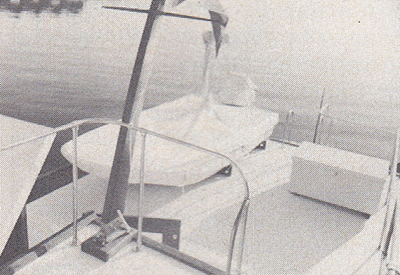 The controls are well placed at both helms, with the upper having a vertical wheel for both sitting and standing and the dash a lift-up plexi panel over the gauges to ward off the weather. The instruments are mounted close to flat so they are visible from all angles, and the control boxes are well laid out with gears to port and throttles to starboard, positioned close to the wheel so the pilot never has a long reach in an emergency.
The controls are well placed at both helms, with the upper having a vertical wheel for both sitting and standing and the dash a lift-up plexi panel over the gauges to ward off the weather. The instruments are mounted close to flat so they are visible from all angles, and the control boxes are well laid out with gears to port and throttles to starboard, positioned close to the wheel so the pilot never has a long reach in an emergency.
You can imagine the view from more than 13 ft up. It’s great for spotting debris, and piloting. The unusual but very pleasant light blue venturi does a good job of redirecting the wind up and away from the passenger area while still giving a clear view through. There’s plenty of room to stand and the sides and rails are all at real-people height for safety.
From the bridge it’s three steps down a teak ladder to the aft cabin roof. Here there is a large fibreglass box for stowing shore power lines and ground tackle. Ahead of this is an area large enough to spread out a cushion and tan; to starboard is a Canoe Cove tender with small outboard, all in cradles. There is a single large davit that lifts and swings the tender over the starboard side. It was neatly done but brought about the only serious piece of criticism I could find on the 48. The outboard on the tender hung out over the aft cockpit, and there is some danger that a person could be thrown or knocked into the engine ‘s lower unit or prop and sustain a nasty cut. The solution would be simple – a padded cover for the engine’s lower unit.
From the cockpit, entering through the master stateroom, you go down three steps. The room is finished with smart teak joinery. There is a bureau or desk along the port side, mirrors and a screened sliding window. The queen sized bed is flanked by night tables – again in teak.
The master head, with a vanity, toilet and shower is at the forward port side. The shower door is another custom touch – pebble-finish glass with wire mesh so it can’t shatter. It is sturdy and a good idea indeed.
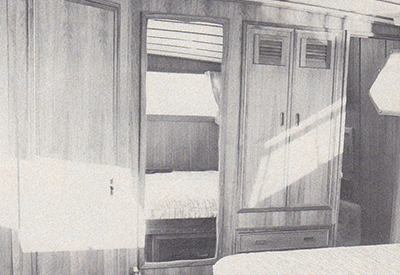 There’s a companionway against the starboard side that leads up a couple of steps into the main cabin. Immediately on entering, one could double back up the hatch ladder to the bridge, or remain in the saloon. The galley is here as well, off to the port side at the rear.
There’s a companionway against the starboard side that leads up a couple of steps into the main cabin. Immediately on entering, one could double back up the hatch ladder to the bridge, or remain in the saloon. The galley is here as well, off to the port side at the rear.
Between the forward end of the galley area and the helm is the port side cabin door. This is a roomy area for easy exit and is likely to be the most frequently used cabin door.
The interior helm is nicely done and has excellent outward vision. There is a swivelling adjustable pylon-mounted helm seat that is armchair-plush, and a ship’s wheel ahead of that, really showing off the teak joinery that is Canoe Cove’s trademark. The electrical master control panel is here, along with all manner of radios, a range finder and a Sperry Auto-Pilot, gimballed compass and depth flasher (and more), all arranged within convenient reach.
To starboard of the helm is a companion’s chair, and aft of this a couch. The owners are replacing the couch in the test boat with one that converts to a foldout queen-size bed. In due course, there will be occasional chairs added and the main cabin will assume a more permanent form than it has now.
Going forward, there is a cavernous hanging locker and opposite that a head with vanity toilet and hand-held shower – both lying under the 48’s massive cabin windshield. Further forward are the V-berths. Two large singles are placed in the conventional manner. The owners have added what they describe as a “grandchild ‘s berth,” which is slightly undersize and runs athwartship at the most forward end of the V-area.
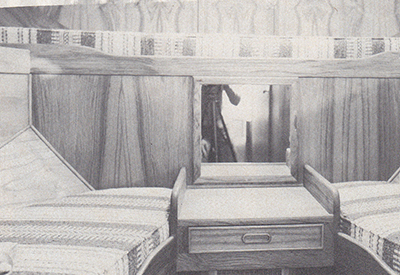 Under the forward companionway stairs is access to an underfloor area the size of the deck house. The 12.5 KW Kohler generator lives here under an insulation blanket to deaden the sound. All around that is space for storage above the boat’s tanks. At first glance, this might seem to be a huge wasted space. On a boat this size, however, areas for storage of supplies and safety equipment are often not given sufficient priority. The Cullen family has room to carry just about anything that will be needed (or discarded) during an extended cruise.
Under the forward companionway stairs is access to an underfloor area the size of the deck house. The 12.5 KW Kohler generator lives here under an insulation blanket to deaden the sound. All around that is space for storage above the boat’s tanks. At first glance, this might seem to be a huge wasted space. On a boat this size, however, areas for storage of supplies and safety equipment are often not given sufficient priority. The Cullen family has room to carry just about anything that will be needed (or discarded) during an extended cruise.
Most of the Canoe Cove line has custom interiors. The builder works to give the buyer whatever he wants, within the scope of the design. Considerable flexibility is available, although this is done at additional cost in most cases. It would be wrong of me to point out, for instance, that there wasn’t really a suitable dining area aboard Tinker Toy because the Cullens wanted it that way. The standard interior plan has plenty of room for that, but it has been used to some extent on this boat by the larger than standard galley and the addition of the swivel companion’s chair.
It is interesting to see so clear a picture of the owners’ tastes as was evident in this serious cruising boat.
Originally published in Canadian Yachting’s May 1980 issue.
Specifications:
Length – 48ft
Engine – Twin Detroit Diesel Allison 6-71TI’s turbo charged.
Photo Captions:
Photo 1 – the Canoe Cove 48 Tri-Cabin
Photo 2 – Helm
Photo 3 – Cupboards abound, and the stove/oven combination has a cutting board top for more counter area. Note double sink.
Photo 4 – Tender swings over side.
Photo 5 – The master stateroom is finished in teak, has a bureau along the port side, mirrors and sliding window.
Photo 6 – Forward of a hanging locker and head is the “grandchildren’s” berth (slightly under-sized) and regular v-berth area.






















